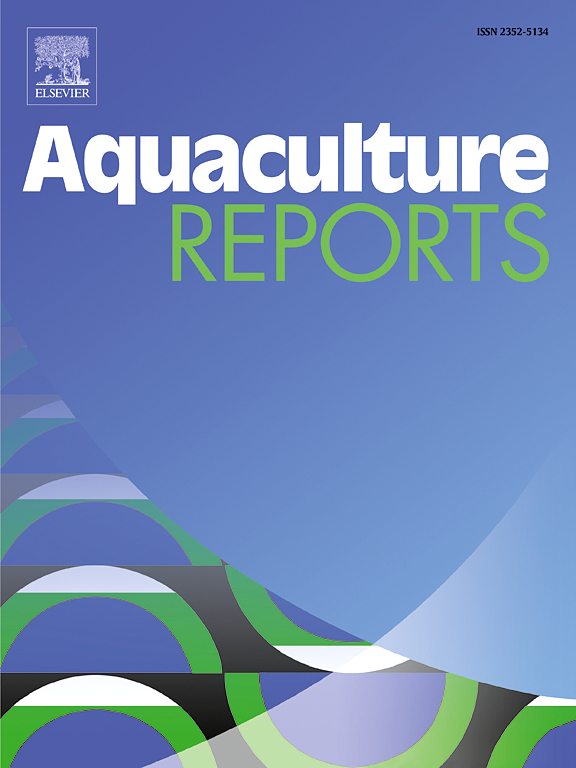Embryonic and larval development of black jewfish, Protonibea diacanthus: A new candidate for aquaculture in northern Australia
IF 3.2
2区 农林科学
Q1 FISHERIES
引用次数: 0
Abstract
Black jewfish Protonibea diacanthus is a large, commercially important fish distributed across the tropical Indo-Pacific. In Australia, there is an established commercial wild fishery for the species but it’s aquaculture potential has not been investigated. This research presents hatchery production of native P. diacanthus in Darwin, Australia and documents ontogeny of early life stages of this species over three trial runs. Wild P. diacanthus were induced to spawn with luteinizing hormone-releasing hormone analog (LHRHa) and eggs were released approximately 25–28 h after injection (0.88 ± 0.01 mm in diameter with oil globule 0.24 ± 0.01 mm). Larvae hatched 12 h after spawning. At one day post hatch (dph) larvae were 2.68 ± 0.01 mm standard length with 0.15 ± 0.01 mm oil globule diameter. Larvae mouths opened at 31 h post hatch (hph) and first feeding was seen at 57 hph. Swim bladder inflation (92 %) occurred between 40 and 62 hph. Larvae were progressively fed rotifers, Artemia and Otohime microdiet, and metamorphosis occurred between 20 and 25 dph, completing as they reached over 13 mm standard length. Tail biting cannibalism began with the onset of metamorphosis and caused significant mortality until approximately 24 dph when metamorphosed juveniles could be handled and moved to low stocking density systems. This study demonstrates that northern Australian P. diacanthus is amenable to hatchery production and provides important foundational knowledge for this emerging aquaculture species.
黑宝石鱼(Protonibea diacanthus)的胚胎和幼体发育:澳大利亚北部水产养殖的新候选品种
黑宝石鱼(Protonibea diacanthus)是一种大型、具有重要商业价值的鱼类,分布于印度洋-太平洋热带地区。在澳大利亚,该物种有成熟的商业野生渔业,但其水产养殖潜力尚未得到研究。本研究介绍了澳大利亚达尔文本地 P. diacanthus 的孵化生产情况,并记录了该物种在三次试验中早期生命阶段的个体发育过程。用黄体生成素释放激素类似物(LHRHa)诱导野生裸鲤产卵,卵在注射后约 25-28 小时释放(直径 0.88 ± 0.01 毫米,油球 0.24 ± 0.01 毫米)。幼虫在产卵后 12 小时孵化。孵化后一天的幼虫标准体长为 2.68 ± 0.01 毫米,油球直径为 0.15 ± 0.01 毫米。幼虫在孵化后 31 h(hph)张开嘴巴,在 57 h(hph)首次进食。鳔充气(92 %)发生在孵化后 40 至 62 hph。幼体在轮虫、Artemia和Otohime微量饲料的喂养下逐渐长大,变态发生在20-25 dph之间,当幼体达到超过13 mm的标准长度时变态完成。咬尾食人行为从开始变态时就开始了,并导致大量死亡,直到约 24 dph 变态幼体可以处理并转移到低放养密度系统时才停止。这项研究表明,澳大利亚北部的 P. diacanthus 适合孵化生产,并为这一新兴水产养殖物种提供了重要的基础知识。
本文章由计算机程序翻译,如有差异,请以英文原文为准。
求助全文
约1分钟内获得全文
求助全文
来源期刊

Aquaculture Reports
Agricultural and Biological Sciences-Animal Science and Zoology
CiteScore
5.90
自引率
8.10%
发文量
469
审稿时长
77 days
期刊介绍:
Aquaculture Reports will publish original research papers and reviews documenting outstanding science with a regional context and focus, answering the need for high quality information on novel species, systems and regions in emerging areas of aquaculture research and development, such as integrated multi-trophic aquaculture, urban aquaculture, ornamental, unfed aquaculture, offshore aquaculture and others. Papers having industry research as priority and encompassing product development research or current industry practice are encouraged.
 求助内容:
求助内容: 应助结果提醒方式:
应助结果提醒方式:


